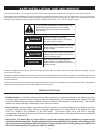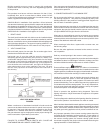
7
INTRODUCTION
This design complies with the current edition of the ANSI Z21.13
low-pressure boiler standard.
Compliance under this standard implies that when the boiler
underwent test, the gas manifold and control assembly pro vided
on the boiler met safe lighting and other performance criteria.
Detailed installation diagrams are found in this manual. These
diagrams will serve to provide the installer a reference for the
materials and methods of piping necessary. It is essential that
all water, gas piping and wiring be installed as shown on the
diagrams. You should thoroughly read and understand this manual
before installation and/or operation of this boiler.
The factory warranty will be void if the boiler(s) have been
improperly installed or operated.
In addition to these instructions, the boiler(s) shall be installed
in accordance with those installation regulations in force in the
local area where the installation is to be made. These shall be
carefully followed in all cases. Authorities having jurisdiction
should be consulted before installations are made.
In the absence of local codes, the installation must comply with the
current editions, as follows:
In the United States:
The National Fuel Gas Code, ANSI Z223.1/NFPA 54 and the
National Electric Code, NFPA 70.
In Canada:
Installation Code CAN/CSA B149.1 and Canadian Electrical Code,
CSA C22.1.
GROUNDING INSTRUCTIONS
This boiler must be grounded in accordance with the National Electrical
Code, Canadian Electrical Code and/or local codes. Correct wiring is
imperative for proper operation.
This boiler must be connected to a grounded metal, permanent
wiring system, or an equipment grounding conductor must be run
with the circuit conductors and connected to the equipment grounding
terminal or lead on the boiler.
CORRECT GAS
MAKE SURE THE GAS ON WHICH THE BOILER WILL
OPERATE IS THE SAME AS THAT SPECI FIED ON THE
BOILER RATING PLATE. DO NOT INSTALL THE BOILER IF
EQUIPPED FOR A DIFFERENT TYPE OF GAS — CONSULT
YOUR SUPPLIER.
PRECAUTIONS
IF THE UNIT IS EXPOSED TO THE FOLLOWING, DO NOT
OPERATE UNTIL ALL CORRECTIVE STEPS HAVE BEEN
MADE BY A QUALIFIED SERVICEMAN:
1. EXPOSURE TO FIRE.
2. IF DAMAGED.
3. FIRING WITHOUT WATER.
4. SOOTING.
IF THE BOILER HAS BEEN EXPOSED TO FLOODING, IT
MUST BE REPLACED.
LIQUEFIED PETROLEUM GAS MODELS
Boilers for propane or liquefied petroleum gas (LPG) are different
from natural gas models. A natural gas boiler will not function
safely on LP gas and no attempt should be made to convert a
boiler from natural gas to LP gas.
LP gas must be used with great caution. It is highly
explosive and heavier than air. It collects first in the low
areas making its odor difficult to detect at nose level.
If LP gas is present or even suspected, do not attempt
to find the cause yourself. Leave the building, leaving
doors open to ventilate, then call your gas supplier or
service agent. Keep area clear until a service call has
been made.
At times you may not be able to smell an LP gas leak.
One cause is odor fade, which is a loss of the chemical
odorant that gives LP gas its distinctive smell. Another
cause can be your physical condition, such as having
a cold or diminishing sense of smell with age. For
these reasons, the use of a propane gas detector is
recommended.
IF YOU EXPERIENCE AN OUT OF GAS SITUATION, DO
NOT TRY TO RELIGHT APPLIANCES YOURSELF. Call
your local service agent. Only trained LP professionals
should conduct the required safety checks in accordance
with industry standards.
HIGH ALTITUDE INSTALLATIONS
Rated inputs are suitable up to 2000 feet (610 m) elevation.
Consult the factory for installation at altitudes over 2000
feet (610 m).


















